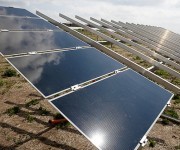This post originally appeared on Energy Self-Reliant States, a resource of the Institute for Local Self-Reliance’s New Rules Project.
Back for a second round, the Open Neighborhoods organization in Los Angeles has organized another group purchase of residential and commercial solar PV, bringing the lifetime cost of solar well under the cost of grid electricity even for individual homeowners.
The savings from the group purchase are enormous. With prices are around $4.40 per Watt installed for solar, Open Neighborhoods gets residential solar for $2 cheaper than the average residential-scale solar prices reported by the Solar Energy Industries Association for the second quarter of 2011. That equates to a 6-cents-per-kilowatt-hour savings on solar over 25 years. Even though solar power is typically cheaper in California than elsewhere in the U.S., the group purchase promises savings of as much as 33 percent on a residential solar array.
The low group purchase price means that those who go solar will have cheaper electricity from their rooftop panels than average grid electricity by 2015 (assuming retail grid prices rise by 3 percent per year). If the solar user is on a time-of-use pricing plan, they’ll have cheaper electricity from solar on day one, during peak hours. The comparison assumes the homeowner accesses both federal tax incentives: the 30 percent tax credit and the depreciation bonus (possible through a lease or power purchase arrangement).
The following chart illustrates the cost of power from a group-purchased rooftop solar array versus grid electricity over the next 25 years:
The results are promising and show that economies of scale can be achieved even with residential solar, if folks work together.
Unfortunately, not all residential customers can get this grid-beating price. There are two federal tax incentives, a 30 percent tax credit and a depreciation tax deduction. The latter can’t be used by homeowners who own their solar array, making the economics for them a lot less favorable than for those who lease their system. The following chart illustrates how much of the cost savings from solar are lost when a residential customer can’t access the depreciation benefit:
The potential cost reductions from group solar raise hopes for more distributed solar power development, but residential solar may not flourish as it could without changes to federal solar incentives.



